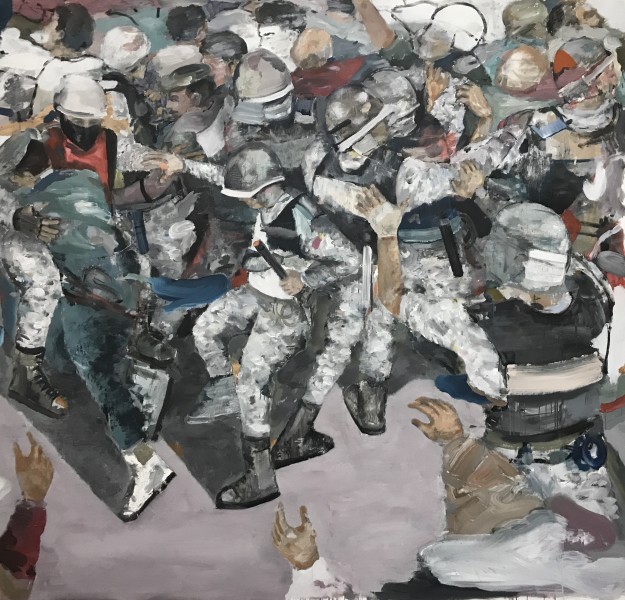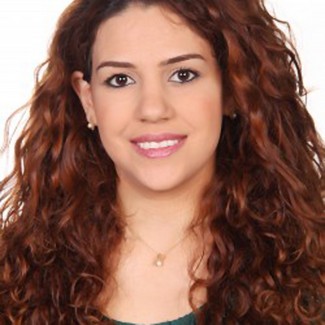In Lebanon in recent years, demands for change have often been accompanied by the strong smell of spray paint and the sound of music. Young people have painted murals and graffitied walls. They’ve joined together in song and dance, and used art in all its forms to courageously denounce the state’s many failures—corruption, impunity, and political dysfunction—and to voice the Lebanese people’s concerns and calls for concrete action. In the process, they reclaimed public spaces that had long sat empty, engaged and mobilized members of their communities on the ground and online, and reached a wider audience that included not only young people, but people from across sectarian divides.
This is not new. Protest art of course dates back generations. One needs only think of Pablo Picasso’s Guernica, the painting of German atrocities during the Spanish Civil War, or the murals of Mexican artists like David Alfaro Siqueiros, and the messages they were created to convey. Yet, in today’s digital world, protest artists now have more tools at their disposal to reach new audiences and allow young people to join the conversation. Around the globe, these artists are amplifying the voices of youth and marginalized groups across societies, breaking down barriers to participation, and catalyzing change in societies transitioning from conflict and repressive regimes.
For many years now, the International Center for Transitional Justice (ICTJ) and other organizations have supported young activists and artists as they harness the power of art, culture, and new media to advance truth, justice, reform, and redress, not only where they live, but across borders and in collaboration with others. This innovative and inspiring work offers lessons about how to increase civic engagement and help societies know the truth about their country’s past and actively shape the national narrative.
Alternative Forms of Expression
Because artists and their artwork can help shape people’s perceptions of the past and imagine a better future, they have played an important role in social movements seeking the truth about past atrocities and demanding change. Rarely can technical and institutional methods alone fully express people’s sufferings and resistance to oppression. They don’t meet people where they are, nor do they appeal to what they need at an emotional level. Art and cultural expression, however, can do that. Music, poetry, photography, visual and performing arts, and other cultural expression can serve to defend human rights and build peace. At the same time, they promote free speech, help us question our beliefs and assumptions about reality, and expose and denounce the effects of armed conflict and oppression.
Hip hop, for example—which encompasses various artistic mediums including deejaying, dancing, rapping, and graffiti—is able to reach a broad public and has helped propel historic social movements. In 2010 and 2011, rap artists such as El General in Tunisia, GAB in Libya, and Omar Offendum in Syria used their voices to take a stand against state repression during Arab Spring protests.
More recently, in Colombia, an international hip hop festival brought together artists and musicians from across Latin America and Africa along with activists, social leaders, and civil society representatives. As part of that festival, ICTJ provided a platform to exchange experiences as well as opportunities for artists to share their music and other expressions of hip hop culture. Artists gave music and dance performances, exhibited artworks, and discussed how hip hop culture can help confront and resist injustice.
Galvanizing People, Challenging Authority, and Demanding Change
In times of social and political turmoil, art can be a powerful tool to galvanize people, challenge authority, and demand change. Many artists in different contexts are deeply committed to creating work that addresses pressing socioeconomic and political problems and lifts up those who are suffering most.
Activists face serious risks especially in countries where freedom of speech is under threat and the state surveils and suppresses dissenting voices. Finding ways for activists to safely conduct activism remotely is necessary. The recent Wide Awake art contest gave artists in Lebanon and Tunisia a safe space in which to create and reflect on powerful, change-inspiring artwork. The contest spotlighted the artists’ works documenting and memorializing their communities’ stories in times of instability, resistance, and change. More than 220 artists submitted entries in a wide range of mediums, including music, painting, sculpture, video, and photography, among others. The artwork reflected the immense talent of the region’s new generation of promising artists and changemakers. Artists from Tunisia, Lebanon, Libya, and Syria had the chance to share their experiences and artwork in Tunisia at an open and inclusive forum where they discussed art’s crucial role in society particularly in engaging citizens in social and political activism. As the contest’s first-place winner said, “It is heartwarming to see that young generations are given the opportunity to have their voices heard by a wider audience.” His short animation film “Amal” (“Hope” in English) was inspired by real-life circumstances that many displaced young people face today.
Raising Awareness About Justice and Reform
In societies undertaking a transitional justice process, the mechanisms are often presented in legalistic and policy terms that many people may find intimidating or alienating. Music and cultural performances can help make the process more meaningful, personal, accessible, and understandable. Music in particular offers a way to raise awareness about the transitional justice process and help shape into a wide-reaching, citizen-driven national process.
In The Gambia, Our Nation Our Voice, an anti-oppression collective of young artists and musicians, used their creative expression to amplify the country’s transitional justice process. Members of the collective wrote and performed music about transitional justice issues, reclaiming the universal slogan “Never Again!” and mobilizing young people to engage in the transitional justice process. Artists held community dialogues on truth, justice, and reform in some of The Gambia’s most forgotten regions and with its most marginalized citizens including children, youth, the elderly, and women survivors of sexual and gender-based violence. As one young man said, it was “education through entertainment.”
Giving Voice to Untold Stories of Violence
Art can help bridge generational gaps and create a more inclusive dialogue in which young people and members of marginalized groups can participate and be heard. Because it is often more personal and accessible, art can help people identify and empathize with the experiences of others. Artwork can stand as a tangible, living testimony to the exclusion and oppression endured by people across societies and promote a deeper understanding of our shared humanity.
In Tunisia, the interactive Voices of Memory exhibition, inspired by a group of nine Tunisian women from different parts of the country and from different generations, helped give voice to the many untold stories of Tunisian women who experienced the effects of repression under the Ben Ali regime. The central theme of the exhibition was the “Koffa,” the traditional Tunisian basket that families used to bring food to their loved ones who were wrongfully detained as political prisoners. That basket is now a symbol of love, defiance, resistance, and solidarity. It represents a protest against forced separation. The exhibition travelled around the country to engage citizens in a dialogue about the universality of women’s experiences and build bridges between generations and among marginalized communities.
Informing Young People and Preserving Memory
Art can be used as a tool to connect young people to a past they did not live, help them understand different perspectives, and encourage discussion about root causes of past and present injustices with a view to building a durable peace and preventing the recurrence of violence.
In Lebanon, there is no overarching national curriculum covering the 15-year civil war from 1975 to 1990. As a result, young people are growing up with limited knowledge of their country’s past. Therefore, it is essential to explore alternative forms of education and new methods of teaching them about what happened outside the formal education system.
To help address this issue, in 2015, ICTJ organized the “The War as I See It” photo contest, which gave young people the opportunity to express their understanding of the Lebanese civil war through photography. Among the many powerful entries was a young woman’s photo of a book from her grandmother’s house that had been pierced by a single bullet during the civil war. The image spoke to the lasting wounds and pain of the war, and the desire by her grandmother to literally hold onto it, to “never forget.” An exhibition featuring winning and notable photos toured the country, sparking discussions among more than 600 young people from different political and religious backgrounds about the war and political violence and what they can do to promote dialogue and build peace.
Breaking the Silence
Storytelling and oral history can also foster intergenerational dialogue and connect the past and the present. In Lebanon, the ICTJ-supported oral history project “Badna Naaref” (“We Want to Know” in English) got young people out into the community to break the silence about the country’s violent past and open up dialogue. Students were trained in oral history techniques and then collected testimonials from their parents, grandparents, and others about the civil war, which helped them understand the experiences of people from different groups in Lebanese society. They were called on to listen, and their elders were given a chance to tell their stories of suffering and survival during the war in Lebanon and be heard. The project served both to commemorate and educate. Some of those stories have been shared as part of a documentary focused on the harsh conditions of daily life during the war, which now serves as an educational and awareness-raising tool for youth about the negative repercussions of political violence.
Opening up spaces for young people to actively participate in transitional justice processes and articulate their perspectives can challenge the status quo and shed light on issues that need to be addressed to build a sustainable peace. Arts and culture can be the vehicle for young people’s participation. They offer a safe place for creativity and healing as well as for coming together to discuss and think through hard issues. They serve as a means for connecting and engaging people from diverse communities and encouraging them to work collaboratively to foster change and advance justice for all.
This story first appeared on the Salam wa Kalam website on July 5, 2022.
____________
PHOTO: Artwork by Lebanese artist Adra Kandil.

